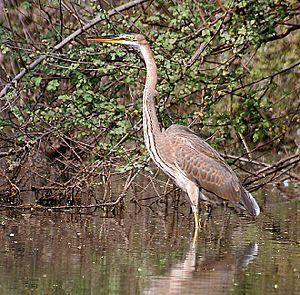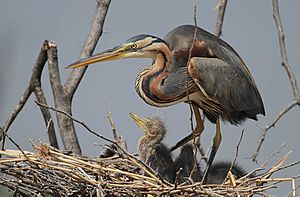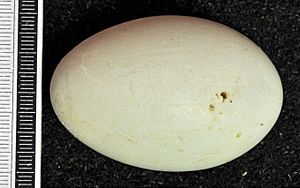Purple Heron facts for kids
Quick facts for kids Purple Heron |
|
|---|---|
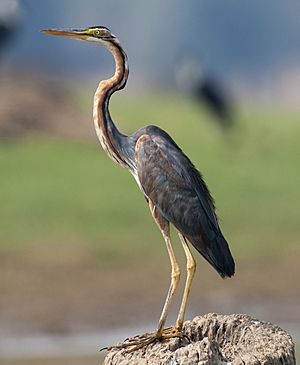 |
|
| Adult from Nagarhole National Park | |
| Conservation status | |
| Scientific classification | |
| Kingdom: | |
| Phylum: | |
| Class: | |
| Order: | |
| Family: | |
| Genus: |
Ardea
|
| Species: |
A. purpurea
|
| Binomial name | |
| Ardea purpurea (Linnaeus, 1766)
|
|
The Purple Heron is a type of bird with long legs. It walks through shallow water to find its food. These birds live and have their babies in Africa, central and southern Europe, and parts of southern and eastern Asia. Its scientific name is Ardea purpurea.
Contents
About the Purple Heron
The Purple Heron is a large bird. It can be about 78 to 97 centimeters (31 to 38 inches) long. When standing, it is about 70 to 94 cm (28 to 37 in) tall. Its wings can spread out from 120 to 152 cm (47 to 60 in). Even though it's big, it's quite slender, weighing only about 0.5 to 1.35 kilograms (1.1 to 3.0 pounds).
It looks a bit like the Grey Heron, but it's smaller. You can tell them apart because the Purple Heron has darker, reddish-brown feathers. Adult Purple Herons have a black forehead and the top of their head. They also have a dark stripe down the back of their neck.
The sides of their head and neck are a light brownish-red color. Their back is a brownish-grey. The front of their neck is lighter, with some long feathers that have white, reddish-brown, and black stripes. Their chest is reddish-brown, and their belly is black.
The beak is long, straight, and strong, usually brownish-yellow. It gets brighter in color when they are ready to breed. Their eyes have yellow irises, and their legs are brown in front and yellowish behind.
The Purple Heron makes a harsh "frarnk" sound. It's usually a quieter bird than the Grey Heron. It also looks less strong and its head and neck are more slender, like a snake. Its toes are very long, which helps it walk on plants.
Where Purple Herons Live
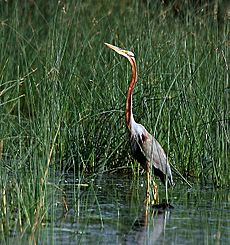
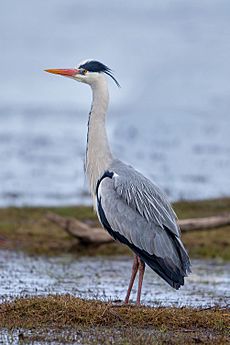
Purple Herons are found in a large area called the Palearctic ecozone. This includes Europe, Asia, and Africa. The western group of these birds lives from southern Spain and North Africa all the way to Kazakhstan. In Africa, they live in Senegal, along the east coast, and in Madagascar.
The eastern group lives from the Indian subcontinent to eastern China and the Philippines. There's also a small group on the Cape Verde Islands.
Migration and Travel
Between August and October, Purple Herons from Europe and western Asia fly south to warmer parts of Africa. They come back north in March. Sometimes, they fly further north than usual, even reaching places like Britain.
Most of the eastern Purple Herons stay in one place. However, some from the northern areas fly south to Korea, Thailand, and Malaysia. The herons in Africa usually stay there all year.
Their Homes
Purple Herons like to live in wet places. They prefer marshes, lagoons, and lakes that have lots of thick plants around them. They especially like areas with reed beds, which are tall grasses. They can also be found in muddy areas, along river banks, and in ditches. On the Cape Verde Islands, they are sometimes seen in more open, dry areas.
Purple Heron Behavior
When a Purple Heron flies, it's slow. It pulls its neck back and its long legs stick out far behind its tail. This is how herons and bitterns fly. It helps tell them apart from storks and cranes, which fly with their necks stretched out.
This bird is quite shy. It spends less time out in the open than the Grey Heron. It often hides in reed beds. Its long toes help it walk on plants floating on the water. It can even walk over bushes without gripping the branches. It doesn't often sit in trees.
Feeding Habits
Purple Herons are most active in the morning and evening. During the middle of the day and at night, they rest with other birds. But when they have young ones, they are more active during the day.
They hunt for food in shallow water. They catch their prey with their strong beak. They often wait very still for food or slowly sneak up on it. Their main diet includes fish, small mammals, and amphibians. They also eat baby birds, snakes, lizards, crustaceans (like crabs), water snails, insects, and spiders. Common insect foods are ground beetles, water beetles, and insect larvae. They also eat grasshoppers, dragonflies, bees, and flies.
Reproduction and Life Cycle
Purple Herons usually build their nests in groups called colonies. Sometimes, they build nests alone. They might also nest with other bird species, like the Goliath Heron or Grey Heron. They usually choose places with reed beds or low bushes near large lakes or wetlands.
They build a large nest from dead reeds, sticks, or whatever materials they can find. The eggs are bluish-green and are about 56 by 45 millimeters (2.2 by 1.8 inches) in size. A female usually lays four or five eggs. Sometimes, they lay seven or eight eggs, but this might happen if two females lay eggs in the same nest.
The eggs are laid about three days apart. The parents might start sitting on the eggs right away or wait until all the eggs are laid. Both parents take turns sitting on the eggs, which takes about 24 to 28 days. They also both help take care of the young.
When an adult brings food, the chicks pull on its beak. The adult then brings up food from its stomach for the chicks to eat. Sometimes, the young birds take food directly from the adult's beak. The young herons are ready to fly at about six weeks old. They become independent at two months old and then spread out to new areas.
Images for kids
-
A Purple Heron in the Bundala National Park, Sri Lanka
See also
 In Spanish: Garza imperial para niños
In Spanish: Garza imperial para niños



